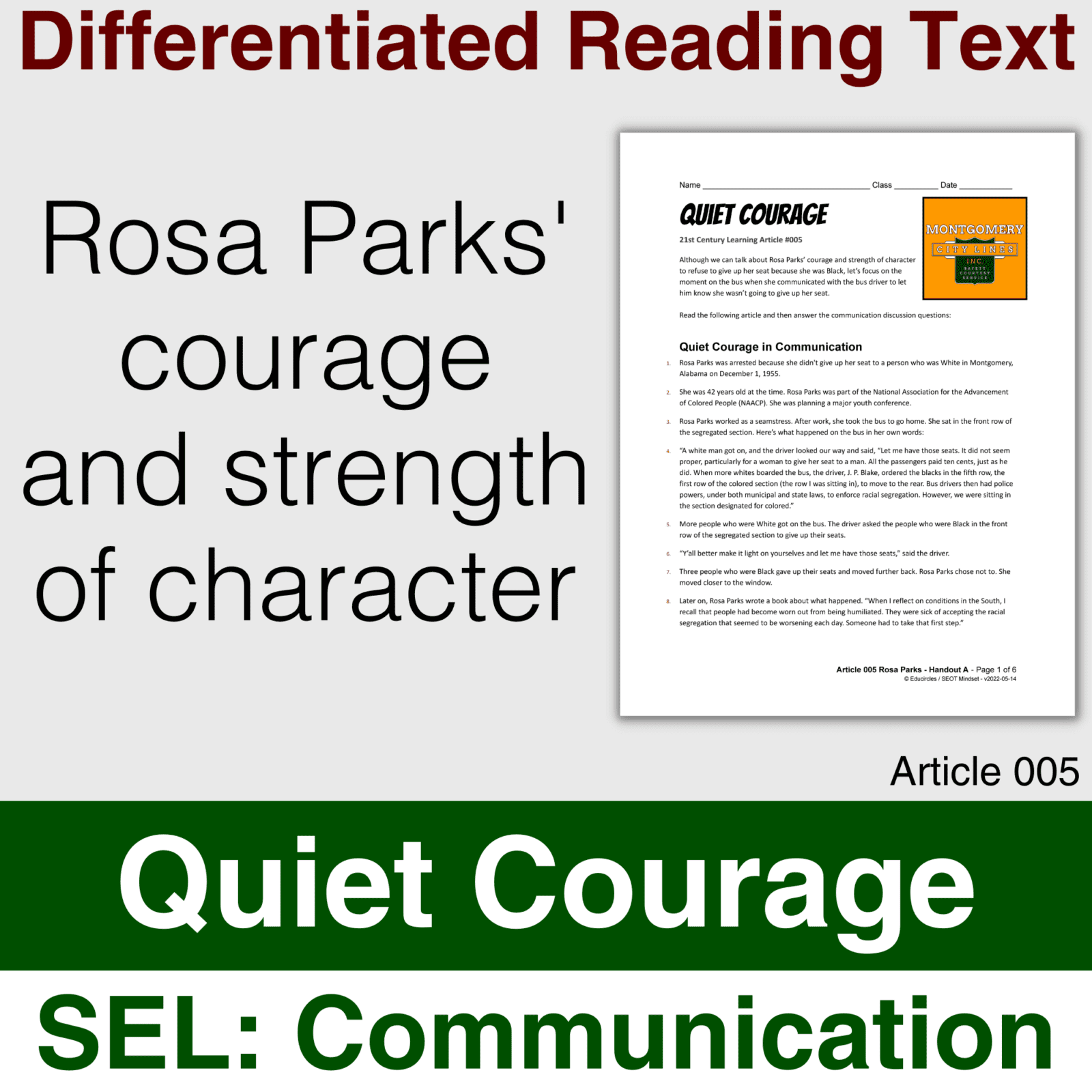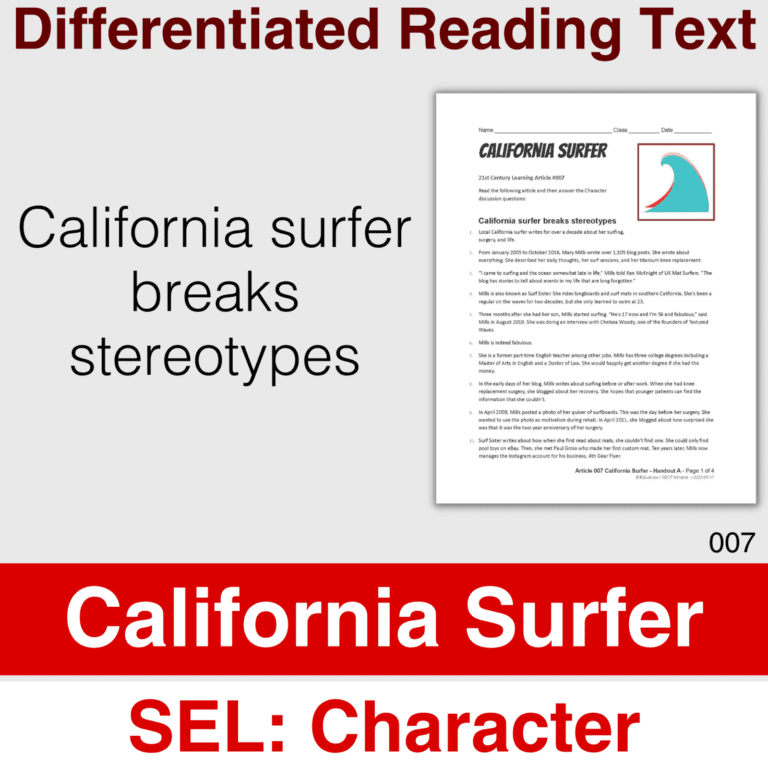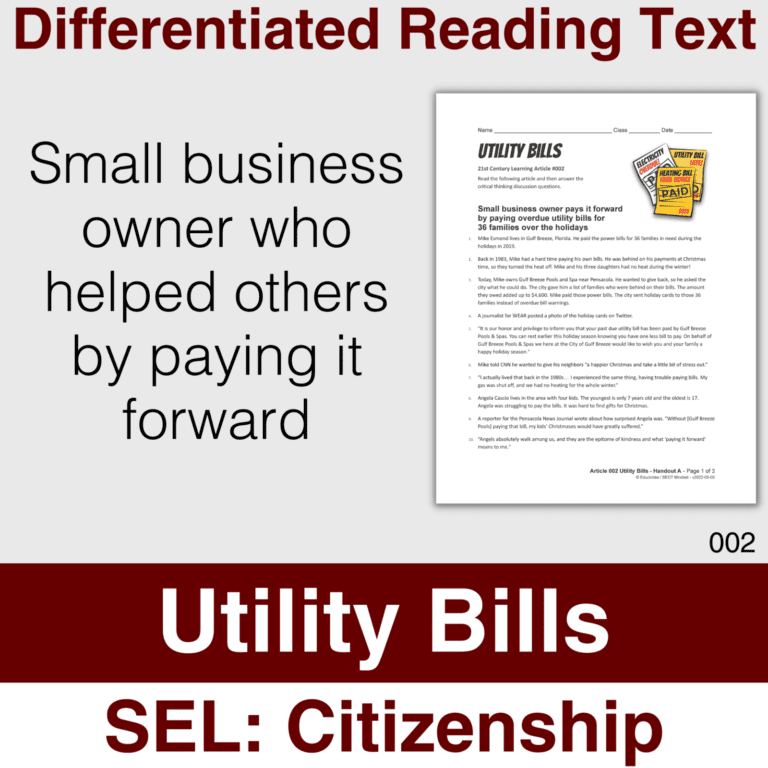High-interest reading article about COMMUNICATION.
Reading comprehension article handout (differentiated Gr 4, 6, 8) about Rosa Parks focusing on her conversation with the bus driver as an example of assertive communication. Includes sample answers.

Want to see exactly what you get before you buy this product?
- Watch the PREVIEW VIDEO
- Look at the PREVIEW PDF.
(It is a watermarked version of the entire PDF resource.)
Quiet Courage in Communication
Rosa Parks was arrested because she didn’t give up her seat to a person who was White in Montgomery, Alabama on December 1, 1955.
She was 42 years old at the time. Rosa Parks was part of the National Association for the Advancement of Colored People (NAACP). She was planning a major youth conference.
Rosa Parks worked as a seamstress. After work, she took the bus to go home. She sat in the front row of the segregated section. Here’s what happened on the bus in her own words:
“A white man got on, and the driver looked our way and said, “Let me have those seats. It did not seem proper, particularly for a woman to give her seat to a man. All the passengers paid ten cents, just as he did. When more whites boarded the bus, the driver, J. P. Blake, ordered the blacks in the fifth row, the first row of the colored section (the row I was sitting in), to move to the rear. Bus drivers then had police powers, under both municipal and state laws, to enforce racial segregation. However, we were sitting in the section designated for colored.”
More people who were White got on the bus. The driver asked the people who were Black in the front row of the segregated section to give up their seats.
“Y’all better make it light on yourselves and let me have those seats,” said the driver.
Three people who were Black gave up their seats and moved further back. Rosa Parks chose not to. She moved closer to the window.
Later on, Rosa Parks wrote a book about what happened. “When I reflect on conditions in the South, I recall that people had become worn out from being humiliated. They were sick of accepting the racial segregation that seemed to be worsening each day. Someone had to take that first step.”
When she got on the bus that Thursday evening, Rosa Parks didn’t plan to get arrested. She wanted to go home. But, at that moment, she made up her mind to stay in her seat. She wasn’t physically tired, but she was tired of the oppression.
This was not an easy decision to make. She knew there were risks if she refused to move. “I knew there was a possibility of being mistreated, but an opportunity was being given to me to do what I had asked of others.”
The bus driver asked her if she was going to stand up. “No. I am not,” she answered.
Rosa Parks was aware that she might be in danger. “Though I knew we needed to strive for nonviolence, when I saw the brutal treatment some of us got, I had trouble believing it was always the best thing to do.”
The bus driver said that he would have to call the police. “Go ahead,” she replied.
J.P. Blake called the police. The police arrested Rosa Parks because city laws gave bus drivers the power to enforce segregation.
Rosa Parks asked one of the police officers, “Why do you push us around?”
“I don’t know,” he answered, “but the law is the law and you’re under arrest.”
None of the people on the bus who knew her did anything. They didn’t even bother telling her husband that she was in jail.
“There were other people on the bus whom I knew. But when I was arrested, not one of them came to my defense. I felt very much alone… In jail I felt even more alone. For a moment, as I sat in that little room with bars, before I was moved to a cell with two other women, I felt that I had been deserted.
Rosa Parks was not the first person in Montgomery arrested for not giving up their seat to a person who was White. But her arrest did start the Montgomery Bus Boycott.
Throughout her life, Rosa Parks continued to speak up for civil rights. Thinking back about the conversations on the bus, Rosa Parks wrote, “Human dignity must be respected at all times. I would have compromised my dignity if I had buckled one more time… I also would have compromised my dignity if I had resisted violently.”
Communication Mini-Lesson
We’ve all had tough conversations – when you want something and the other person you are communicating with wants something else.
Just because you disagree about something doesn’t always make a conversation tough. For example, if you want to see an action movie and your friend wants to watch a comedy, but it doesn’t really matter to either of you, then we don’t really have any conflict.
Tough conversations happen when you want something, the other person wants something else, and this is important to both of you. Now what?
Here are four styles of communication in tough conversations. They differ based on what outcome you’re working towards – who “wins” and who “loses.”
1. ASSERTIVE communication style: The Diplomat
- You could be “the diplomat” (assertive) where your needs come first in a respectful way.
- You win because you set personal boundaries and limits on what you’re willing to do/accept.
- You’re also working to help the other person win because you’re trying to find a solution that works for them (as long as you don’t compromise your personal boundaries/limits.)
2. AGGRESSIVE communication style: The Steam Roller
- You could be “the steamroller” (aggressive) where your needs come first no matter what – you win, and they lose.
3. PASSIVE-AGGRESSIVE communication style: The Rain Cloud
- You could be “the rain cloud” (passive-aggressive) where their needs come first (begrudgingly with indirect resistance).
- They win, and you might win or lose depending on what the other person does because of how unhappy you act or pushback.
4. PASSIVE communication style: The Door Mat
- Finally, you could be “the doormat” (passive) – they win, and you lose.
- You avoid confrontation at all cost.
Being assertive is tough.
Here are five things to look for in assertive behaviour:
- Respectfully stand up for your point of view by telling the other person what you want.
- Set personal boundaries and limits on what you are willing to do / accept. You’re willing to compromise as long as it doesn’t cross your limits.
- Your needs come first.
- You consider the rights and beliefs of others and their points of view.
- Courageous direct confrontation by being true to yourself and considerate of others.
Based on this article, what type of communication style can we infer Rosa Parks used?
Reading Comprehension Questions
Based on this communication mini-lesson, how would you answer the following questions:
- Why was this a tough conversation between the bus driver and Rosa Parks?
- Based on this article, what type of communication style can we infer Rosa Parks used?
- What communication style did the bus driver use?
- Think of a tough conversation that you’ve had. Why was it tough? What communication style did you use?
- Does being assertive always work? Why or why not?





